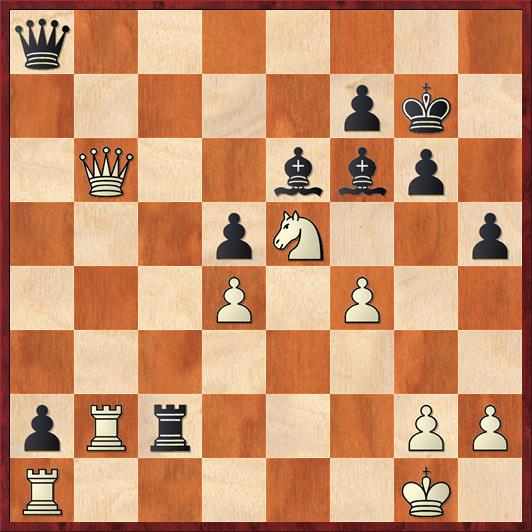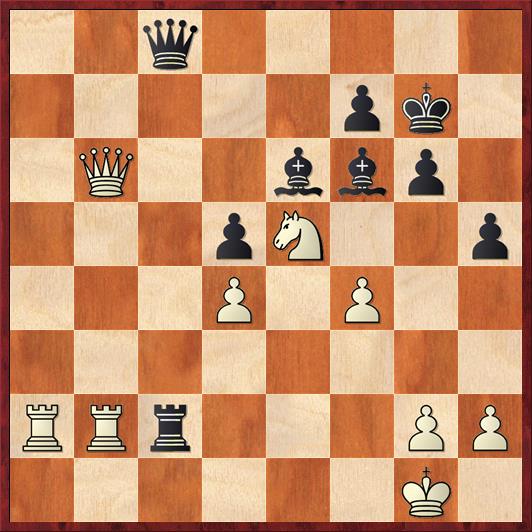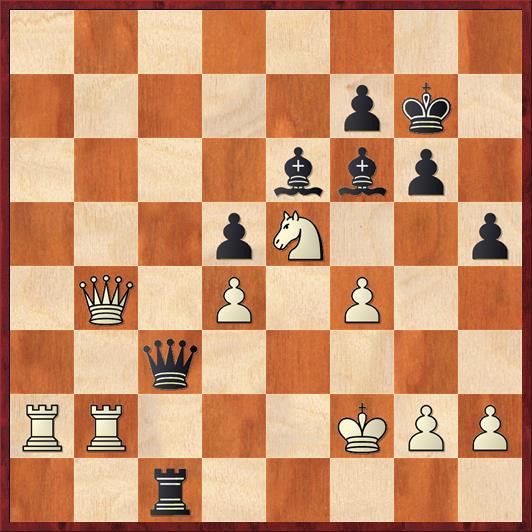Last weekend I played a 7-minute game that combined three of the things that I am best known for: the Bird Variation of the Ruy Lopez, the Hook and Ladder Trick, and … losing on time. Although I have written about the Hook and Ladder Trick many times and recorded a ChessLecture on it, I believe this may be the first time I have ever gotten a chance to play it myself. But my flag fell before I could complete the combination!
In fact, you can argue that I still haven’t played a complete Hook and Ladder. The name comes from the fact that the victim’s queen stands on top of a “ladder,” supported by a rook at the base. The first move of the combination is to “hook” the rook at the base so that it has to move to the side and the queen loses her support. The second step is to grab the queen from the top of the ladder. I played the “Hook” part but I never got to play the “Ladder”!
Okay, let’s look at the game. My opponent, who was both the victim and the winner, was Austen Green. The opening went well and I got a winning position in the middlegame. But then I simply forgot to defend a pawn that was under attack, and after that the position got pretty murky. I decided to sacrifice an exchange, and Austen probably misplayed the defense, and we got to this position.
 Position after 36. Rb2. Black to move.
Position after 36. Rb2. Black to move.
FEN: q7/5pk1/1Q2bbp1/3pN2p/3P1P2/8/pRr3PP/R5K1 b – – 0 36
You can see that I had pinned my hopes on the advanced a-pawn, but White now has it surrounded and it doesn’t appear that Black can save it. The funny thing is that I thought I was probably losing here, and I was just trying to make things as hard for Austen as I could. But Rybka says I am winning! Do you see why?
The first step is pretty obvious: I played 36. … Qc8. The threat is 37. … Rc1+ followed by trading rooks and queening the a-pawn. So White has to do something right away.
(a) The rook trade 37. Rxc2? fails because of the sweet idea 37. … Qxc2 38. Qa5 Qb1! 39. Qe1 Bf5! Now I’m threatening to take the queen, and if White plays (say) 40. Kf2 then 40. … Qb2+ 41. Kf1 Bb1 buries the rook.
(b) White’s best move is 37. Rbxa2. But then Black easily wins back a pawn after 37. … Rxa2 38. Rxa2 Qc1+ 39. Kf2 Qxf4+. White can set up a pretty solid defensive formation with 40. Nf3, but 40. … g5! keeps up the pressure. In fact, Rybka says it is winning (a 1.77-pawn advantage for Black), but I’ll spare you the details.
(c) Austen instead took the other way: 37. Raxa2? This is arguably the worst move on the board, because Black now has a mate in four! Do you see it?
 Position after 37. Raxa2. Black to play and mate in four.
Position after 37. Raxa2. Black to play and mate in four.
FEN: 2q5/5pk1/1Q2bbp1/3pN2p/3P1P2/8/RRr3PP/6K1 b – – 0 37
In the game I played 37. … Rc1+, which is an “automatic move” if there ever was one. I doubt that I thought about it more than a second. (Remember, we’re playing 7-minute chess, and I am down to less than a minute.) My thinking process was: “He’s attacking my rook. I don’t want to trade it. So I’d better move it. Oh, look, I can check on the back rank.”
My jaw dropped when I put this game on Rybka and saw its move: 37. … Qc3!! Of course the main point is that if 38. Rxc2 Qe1 mate follows. But even if White defends that mate, he can do nothing about Black’s equally strong backup threat, 38. … Qe3+. For example, if White gives up a rook with 38. Ra1 (for example), Black does not need to take the rook — he can simply play for mate with 38. … Qe3+! 39. Kh1 Rc1+ 40. Rxc1 Qxc1 mate. In fact, on any conceivable White move, Black mates in four moves or less. Just ask Rybka.
I’m bummed out that I missed this move. But I got a nice consolation prize.
After 37. … Rc1+ 38. Kf2 now I played the move I should have played earlier: 38. … Qc3! It’s not quite as strong as before because I no longer have the check at e3, but it still should win with best play. White’s best defense was 39. Nf3, after which Rybka worked out a likely win after 39. … Bh4+!! 40. g3 Qd3!! 41. Re2 (all of White’s moves are forced) Bxg3+!! 42. hg Rc3 43. Ne1 Qxg3+ etc. Sorry about all the exclamation points, but this is mind-blowing stuff. I actually figured out the first two moves (39. … Bh4+ and 40. … Qd3) on my own at home, but I never would have found them in a speed game, especially 40. … Qd3, a stunning “quiet move” that allows Black to create a battery on his sixth rank.
However, Austen played the very plausible-looking defense 39. Qb4, which seems to have nothing wrong with it. Do you see the hidden flaw?
 Position after 39. Qb4. Black to move.
Position after 39. Qb4. Black to move.
FEN: 8/5pk1/4bbp1/3pN2p/1Q1P1P2/2q5/RR3KPP/2r5 b – – 0 39
I used up almost all of my time and then I saw it: 39. … Rc2+!! It’s the Hook and Ladder Trick! Gjon Feinstein and Mike Splane, who were watching the game, started talking about chutes and ladders, and at first I thought they were joking. To be honest, I thought at first that it was just similar to the Hook and Ladder. But no, it’s the real deal. It has both of the usual points of the Hook and Ladder Trick: If 40. Rxc2 Qxb4 wins the queen for a rook and if 40. Kf1 (which Austen played) Qxb4 41. Rxb4 Rxa2 wins a rook outright. Either way, Black is easily winning.
One reason I didn’t recognize it at first is that every other example I’ve ever seen has been on the back rank. Also, it’s unusual because Black’s rook retreats to the checking square instead of advancing to it. But as it turned out, Gjon and Mike’s kibitzing didn’t matter because my flag fell after Austen played 40. Kf1. So I only got the moral victory, and he got the real victory.
What a weird finish! But a cool one, chock full of brilliancies. I’m disappointed that I missed 37. … Qc3. I hope that I would see that in a tournament game, but in a speed game with just seconds left it’s hard to see leaving your rook en prise. I should have remembered another principle that I once talked about on ChessLecture: if you see two good moves in a row (here, … Rc1+ and … Qc3), always check to see if they are even better when played in the reverse order.
I’m thrilled that I got a chance to play the tactic that I named and introduced to the chess world, the Hook and Ladder Trick. But I’m disappointed that it took me so long to find it that I didn’t have enough time to seal the deal. Hopefully I’ll get another chance some day, and not just in a blitz game!



{ 2 comments… read them below or add one }
Indeed 37… Hc3 and 39… Rc2 are a very beautiful moves!
Dana, you should check out Shankland-Lenderman in round 10 of the US Champs, especially around white move 42 and 44. Shankland was really frustrated at settling for draw. In analysis, the hook and ladder trick appear and they were probably why Lenderman sacced the exchange on move 42. 42.Qc2 and 44.Rf7 look like improvements for White.